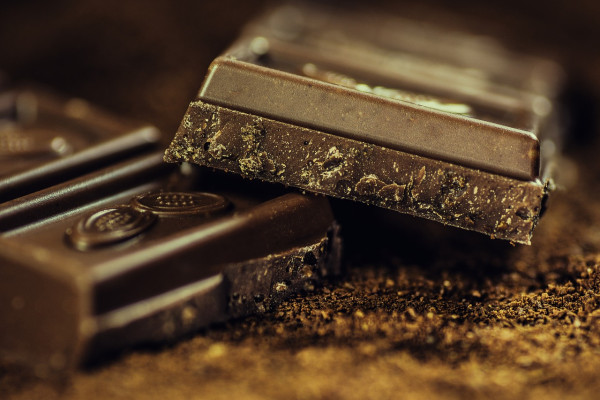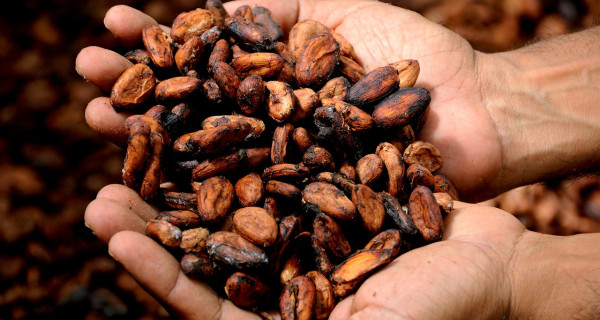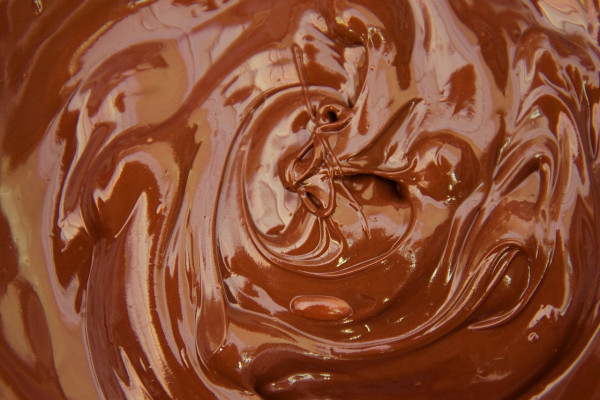© Pint of Science, 2025. All rights reserved.
It’s Easter and chocolate eggs are in abundance! But have you ever stopped to wonder about the science behind the delicious treats we enjoy? Welcome to Willy Wonka's Chemistry Factory, where we'll explore the intricate chemical processes that turn bitter cocoa beans into the mouth-watering chocolate we all love.
Chocolate production involves fermentation, drying, roasting, grinding cocoa beans, conching, and tempering. All of these stages involve complex chemical reactions which are important for flavour and aroma development. So sit back, relax, eat some chocolate, and learn a little about the process.

Dark Chocolate
- Fermentation – cocoa plantations
The first step of cocoa bean processing is fermentation. Cocoa pods are harvested from trees which contain cocoa beans embedded in a white pulp. During fermentation, which can take up to eight days, yeasts and bacteria convert sugars such as sucrose in the pulp into alcohol, and important precursors to future reactions are formed.
For the first 24-36 hours, anaerobic yeasts are dominant in the fermentation process. Sucrose is broken down into glucose and fructose by proteins called enzymes. Anaerobic yeasts then liquefy these sugars into alcohol, which supports growth of lactic acid bacteria. Beans are turned after 48 hours which brings air into the mix and supports growth of acetic acid bacteria that can convert the alcohol into acetic acid via aerobic respiration. The conversion of alcohol into acetic acid is an exothermic reaction, meaning it gives off a lot of heat. The temperature will rise up to 50°C, the bud (or germ) of the bean will die, and this triggers a release of enzymes.
2. Drying – cocoa plantations
After fermentation, the beans have to be dried to lower the moisture content to prevent mould growth and make them stable enough to transport. After this stage, the beans are transported to chocolate factories for the remainder of their processing.

Cocoa Beans
3. Roasting – chocolate factory
Roasting occurs at high temperatures of 120-140°C which allows for protein degradation, Maillard reactions, and caramelization to occur. Maillard reactions are important non-enzymatic reactions which develop the flavour and aroma of the cocoa beans. Maillard reactions occur due to a chemical reaction between amino acids and carbohydrates in reducing sugars. Heat is important for this process as it provides the energy needed for these chemical reactions to occur. The resulting product of this reaction is a brown polymer, called a malanoidin, which causes the typical browning.
Roasting also causes caramelisation of sugars. Caramelization causes a similar browning to the maillard reactions but is a distinct process, it occurs in the absence of proteins or amino acids and results in degradation of sugars.
4. Grinding and conching – chocolate factory
Particle size is also important for taste and overall chocolate experience. Cocoa beans are ground into a fine powder and all the ingredients undergo a process of heating and mixing called conching. During this process, the individual cells rupture and fat from inside the cell coats the solid chocolate particles creating liquid chocolate. Conching is important to remove the acidic flavour, and reduce the moisture in the product to improve viscosity.
5. Tempering – chocolate factory
Finally, the liquid chocolate is tempered. Cocoa butter is rich in fat called triacylglycerols (TAGs). These fats in cocoa butter can crystallise into six different polymorphic forms that all have slightly different chemical properties, such as melting points, texture, and colour. The most desirable form is β(V) which is a solid at room temperature, melts in the mouth and has a shiny, smooth texture. Chocolate is tempered to turn it all into β(V).
Tempering is a process of slowly cooling the melted chocolate and re-heating to just below the melting point of β(V), in order to melt all the other forms with a lower melting point. As the chocolate slowly cools, it follows the pattern of the existing β(V) crystals and results in a uniform solid chocolate.

Tempered Chocolate
And tada! You have a perfect bar of chocolate. Although don’t leave those Easter eggs sitting around for too long. After several months the β(V) crystal structure will transform into a more stable form, β(VI). It is still perfectly safe to eat, however it will affect the overall quality and can cause fat bloom, which is where fats to rise to the surface and causes those white speckles.
So enjoy those chocolate eggs quickly, and whilst you’re eating have a think about all the different chemical reactions that had to occur to make that delicious treat.
About the Author
Poppy Nathan is a PhD student at the University of Birmingham studying immunology and inflammation. She is investigating how immune cells move around the body and how this is affected in inflammatory disease. Poppy is passionate about science communication and public engagement. You can find her on twitter @poppynathan
Featured photos by AnnieSpratt, AlexanderStein, 5671698, and PublicDomainPictures from Pixabay



